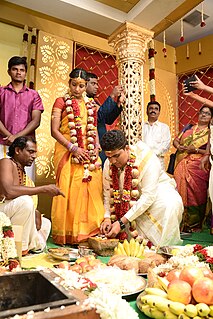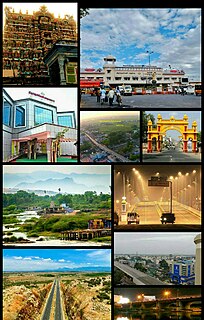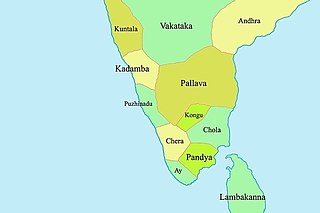Related Research Articles

Tamil Nadu is a state in southern India. Its capital and largest city is Chennai. The state is the home of the Tamil people, whose Tamil language—one of the longest surviving classical languages in the world—is widely spoken in the state and serves as its official language.

The following outline is provided as an overview of and topical guide to the history of South Asia:

Irrigation is the agricultural process of applying controlled amounts of water to land to assist in the production of crops, as well as to grow landscape plants and lawns, where it may be known as watering. Agriculture that does not use irrigation but instead relies only on direct rainfall is referred to as rain-fed. Irrigation has been a central feature of agriculture for over 5,000 years and has been developed independently by many cultures across the globe.

Madurai is one of the longest living cities in the world and a major city in the Indian state of Tamil Nadu. It is the cultural capital of Tamil Nadu and the administrative headquarters of Madurai District. As of the 2011 census, it was the third largest Urban agglomeration in Tamil Nadu after Chennai and Coimbatore and the 44th most populated city in India. Located on the banks of River Vaigai, Madurai has been a major settlement for two millennia and has a documented history of more than 2500 years. It is often referred to as "Thoonga Nagaram", meaning "the city that never sleeps".

The Tamil people, also known as Tamilar, or simply Tamils, are a Dravidian ethno-linguistic group who trace their ancestry mainly to India’s southern state of Tamil Nadu, union territory of Puducherry and to Sri Lanka. Tamils constitute 5.9% of the population in India, 15% in Sri Lanka, 7% in Malaysia, 6% in Mauritius, and 5% in Singapore.

The Pandya dynasty, also referred to as the Pandyas of Madurai, was an ancient dynasty of South India, and among the three great kingdoms of Tamilakam, the other two being the Cholas and the Cheras. Extant since at least the 4th to 3rd centuries BCE, the dynasty passed through two periods of imperial dominance, the 6th to 10th centuries CE, and under the 'Later Pandyas'. The Pandyas ruled extensive territories, at times including regions of present-day South India and northern Sri Lanka through vassal states subject to Madurai.

Krishna Raja Sagara, also popularly known as KRS, is a lake and the dam that creates it. They are close to the settlement of Krishna Raja Sagara in the Indian State of Karnataka. The gravity dam made of surki mortar is below the confluence of river Kaveri with its tributaries Hemavati and Lakshmana Tirtha, in the district of Mandya.

Tirunelveli, also known as Nellai and historically as Tinnevelly, is a major city in the Indian state of Tamil Nadu. It is the administrative headquarters of the Tirunelveli District. It is the sixth-largest municipal corporation in the state after Chennai, Coimbatore, Madurai, Tiruchirappalli and Salem. Tirunelveli is located 700 km (430 mi) southwest of the state capital Chennai, 58 km (36 mi) away from Thoothukudi, and 73 km (45 mi) from Kanyakumari. The downtown is located on the west bank of the Thamirabarani River; its twin Palayamkottai is on the east bank. Palayamkottai is called the Oxford of South India as it is a hub of many schools and colleges. It boasts several important government offices.

The following outline is provided as an overview of and topical guide to ancient India:

The history of science and technology in the Indian subcontinent begins with the prehistoric human activity of the Indus Valley Civilization to the early Indian states and empires.

Kallanai is an ancient dam. It is built across the Kaveri river flowing from Tiruchirapalli District to Thanjavur district, Tamil Nadu, India. The dam located in Thanjavur district. Located at a distance of 15 km from Tiruchirapalli, 45 km from Tanjavur, the dam was originally constructed during the reign of Chola king Karikalan in c.150 AD. It is the fourth oldest water diversion or water-regulator structures in the world and the oldest in India that is still in use. Because of its spectacular architecture, it is one of the prime tourist spots in Tamil Nadu.

Kongu Nadu, also known by various names as Kongu Mandalam and Kongu belt, is a geographical region comprising present day parts of western Tamil Nadu, southeastern Karnataka and eastern Kerala. In the ancient Tamilakam, it was the seat of the Chera kings, bounded on the east by Tondai Nadu, on the south-east by Chola Nadu and on the south by Pandya Nadu regions.

Tirunelveli district is one of the 38 districts of Tamil Nadu state in India. It is the largest district in terms of area with Tirunelveli as its headquarters. The district was formed on 1 September 1790 by the British East India Company, and comprised the present Tirunelveli and Thoothukudi, Tenkasi and parts of Virudhunagar and Ramanathapuram district. As of 2011, the undivided district had a population of 3,077,233.

Tamiḻakam, alternatively spelled Thamizhagam, refers to the geographical region inhabited by the ancient Tamil people. Tamilakam covered today's Tamil Nadu, Kerala, Puducherry, Lakshadweep and southern parts of Andhra Pradesh and Karnataka. Traditional accounts and the Tolkāppiyam referred to these territories as a single cultural area, where Tamil was the natural language and permeated the culture of all its inhabitants. The ancient Tamil country was divided into kingdoms. The best known among them were the Cheras, Cholas, Pandyans and Pallavas. During the Sangam period, Tamil culture began to spread outside Tamilakam. Ancient Tamil settlements were also established in Sri Lanka and the Maldives (Giravarus).

Namakkal District is one of the 38 districts in the state of Tamil Nadu, India. The district was bifurcated from Salem District with Namakkal town as headquarters on 25 July 1996 and started to function independently from 1 January 1997. The district has seven taluks (subdivisions): Tiruchengode, Namakkal, Rasipuram, Paramathi Velur, Sendamangalam, Kumarapalayam, Kolli Hills and Mohanur. It has two revenue divisions: Tiruchengode and Namakkal. As of 2011 census, Namakkal district had a population of 1,726,601 with a sex-ratio of 986 females for every 1,000 males and Tiruchengode is the largest city in terms of population. Namakkal district is geographically affiliated to Kongu Nadu region. The district is famous for its large poultry industry, egg production and lorry bodybuilding industry, for which it is often referred to as "Egg City" and "Transport Hub of South India".

Thuluva Vellalar, also known as Agamudaya Mudaliars and Arcot Mudaliars, is a caste found in northern Tamil Nadu, southern Andhra Pradesh and southern Karnataka, India. They were originally significant landowners.

Indian agriculture began by 9000 BCE on north-west India with the early cultivation of plants, and domestication of crops and animals. Indian subcontinent agriculture was the largest producer of wheat and grain. They settled life soon followed with implements and techniques being developed for agriculture. Double monsoons led to two harvests being reaped in one year. Indian products soon reached the world via existing trading networks and foreign crops were introduced to India. Plants and animals—considered essential to their survival by the Indians—came to be worshiped and venerated.

The Anuradhapura period was a period in the history of Sri Lanka of the Anuradhapura Kingdom from 377 BC to 1017 AD. The period begins when Pandukabhaya, King of Upatissa Nuwara moved the administration to Anuradhapura, becoming the kingdom's first monarch. Anuradhapura is heralded as an ancient cosmopolitan citadel with diverse populations.

The early Dravidian religion constituted a non-Vedic form of Hinduism in that they were either historically or are at present Āgamic. The Agamas are non-Vedic in origin, and have been dated either as post-Vedic texts, or as pre-Vedic compositions. The Agamas are a collection of Tamil and Sanskrit scriptures chiefly constituting the methods of temple construction and creation of murti, worship means of deities, philosophical doctrines, meditative practices, attainment of sixfold desires and four kinds of yoga. The worship of tutelary deity, sacred flora and fauna in Hinduism is also recognized as a survival of the pre-Vedic Dravidian religion. Dravidian linguistic influence on early Vedic religion is evident, many of these features are already present in the oldest known Indo-Aryan language, the language of the Rigveda, which also includes over a dozen words borrowed from Dravidian. The linguistic evidence for Dravidian impact grows increasingly strong as one moves from the Samhitas down through the later Vedic works and into the classical post-Vedic literature. This represents an early religious and cultural fusion or synthesis between ancient Dravidians and Indo-Aryans that went on to influence Indian civilization.

Irrigation in India includes a network of major and minor canals from Indian rivers, groundwater well based systems, tanks, and other rainwater harvesting projects for agricultural activities. Of these groundwater system is the largest. In 2013–14, only about 36.7% of total agricultural land in India was reliably irrigated, and remaining 2/3 cultivated land in India is dependent on monsoons. 65% of the irrigation in India is from groundwater. Currently about 51% of the agricultural area cultivating food grains is covered by irrigation. The rest of the area is dependent on rainfall which is most of the times unreliable and unpredictable.
References
- ↑ P R Vijayasarathy (2011). Engineering Chemistry. PHI Learning Pvt. Ltd. p. 136. ISBN 9788120342798.
- ↑ Jagat Pati Joshi. Harappan Architecture and Civil Engineering. Rupa Publication. p. 16.
- ↑ Pierre-Louis Viollet (2007). Water Engineering in Ancient Civilizations: 5,000 Years of History. CRC Press. p. 11.
- ↑ Partha Chakraborty, Animesh Das. Principles of Engineering. PHI Learning Pvt. p. 1.
- 1 2 Kumkum Bhattacharyya (2011). The Lower Damodar River, India: Understanding the Human Role in Changing Fluvial Environment. Springer Science & Business Media. p. 5. ISBN 9789400704671.
- ↑ Ornstein, Daniel U. Levine (2002). Foundation of Eduspace, Eighth Edition, Custom Publication. Houghton Mifflin. p. 64.
- ↑ Charles Gilmore (2014-01-01). Materials Science and Engineering Properties. CengageBrain. p. 393. ISBN 9781305156197.
- ↑ Charles Gilmore (2014-01-01). Materials Science and Engineering Properties. CengageBrain. p. 320. ISBN 9781305156197.
- ↑ Pushpendra K. Agarwal, Vijay P. Singh (2007). Hydrology and Water Resources of India. Springer Science & Business Media. p. 937. ISBN 9781402051807.
- ↑ Debi Prasad Chattopadhyaya (1999). History of Science, Philosophy and Culture in Indian Civilization: pt. 1. Science, technology, imperialism and war. Pearson Education India. pp. 435–440.
- ↑ Gaurav Rastogi (2011). Offshore: How India Got Back on the Global Business Map. Penguin UK. p. 153. ISBN 9788184755381.
- ↑ Nandini Gooptu. Enterprise Culture in Neoliberal India: Studies in Youth, Class, Work and Media. Routledge. p. 46.